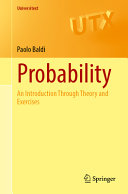

Most ebook files are in PDF format, so you can easily read them using various software such as Foxit Reader or directly on the Google Chrome browser.
Some ebook files are released by publishers in other formats such as .awz, .mobi, .epub, .fb2, etc. You may need to install specific software to read these formats on mobile/PC, such as Calibre.
Please read the tutorial at this link: https://ebookbell.com/faq
We offer FREE conversion to the popular formats you request; however, this may take some time. Therefore, right after payment, please email us, and we will try to provide the service as quickly as possible.
For some exceptional file formats or broken links (if any), please refrain from opening any disputes. Instead, email us first, and we will try to assist within a maximum of 6 hours.
EbookBell Team

5.0
78 reviewsMathematics Subject Classification: • 60-XX Probability theory and stochastic processes
This textbook offers a complete one-semester course in probability, covering the essential topics necessary for further study in the areas of probability and statistics.
The book begins with a review of the fundamentals of measure theory and integration. Probability measures, random variables, and their laws are introduced next, along with the main analytic tools for their investigation, accompanied by some applications to statistics. Questions of convergence lead to classical results such as the law of large numbers and the central limit theorem with their applications also to statistical analysis and more. Conditioning is the next main topic, followed by a thorough introduction to discrete time martingales. Some attention is given to computer simulation. Through the text, over 150 exercises with full solutions not only reinforce the concepts presented, but also provide students with opportunities to develop their problem-solving skills, and make this textbook suitable for guided self-study.
Based on years of teaching experience, the author's expertise will be evident in the clear presentation of material and the carefully chosen exercises. Assuming familiarity with measure and integration theory as well as elementary notions of probability, the book is specifically designed for teaching in parallel with a first course in measure theory. An invaluable resource for both instructors and students alike, it offers ideal preparation for further courses in statistics or probability, such as stochastic calculus, as covered in the author's book on the topic.